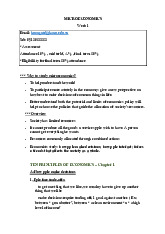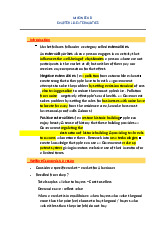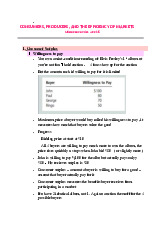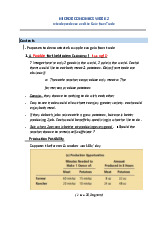






Preview text:
lOMoAR cPSD| 59114765
CHAPTER 14: FIRM IN COMPETITIVE MARKET MIC WEEK 10 I. INTRODUCTION
- Your local dairy company raised ít price for milk products by 20%.
- A market is compettive if each buyer & seller is small compared to the
size of market , n therefore has little ability ro influence market prices
- If a firm can influence the market price of good it sells, it is said to have market power. II.
WHAT IS A COMPETITIVE MARKET?
1. The meaning of competition
- A competitive market, also called perfectly competitive market, has 2 characteristics:
+ There are many buyers n many sellers in that market.
+ The goods offered by the various sellers are largely the same
Actions of any single buyer or seller in that market have a negligible impact on the market price
Buyer n seller must accept price market determined They are price takers (ex: market for milk)
+ Firm can freely enter or exit the market .
- A firm in a competitive market, like most other firms in the economy ,
tries to maximize profit ( i.e: tries to maximum total revenue..)
2. The revenue of a Competitive Firm
- To see how firm does it, we consider revenue of a competitive firm -
Case: Vaca Family dairy farm
+ Produce n sell 1,000 gallons + Price: $6/ gallon
+ Bcs Vaca Farm is small compared to the world market for milk
Vaca price take the price as given by market condition. lOMoAR cPSD| 59114765
+ If Vaca produces 2,00 gallons, price remain same
Total revenue : 2,000 x 6 =12,000
- 2 questions are considered:
- Answer in the last 2 columns
+ Average Revenue = Total revenue / quantity sold
+ Marginal revenue: the change in total revenue from an additional unit sold.
- Result in table - MR equals $6, the price of a gallon of mailk –
illustrates a lesson that applues only to competitive firms
- For competitive firms , marginal revenue equals the price of a goods.
III. PROFIT MAXIMIZATION AND THE COMPETITIVE FIRM’S
SUPPLY CURVE 1. A simple example of profit Maximization
- The goal of a competitive firm is to maximize profit lOMoAR cPSD| 59114765
- Another way to look at Vaca Farm’s decision:
- Recall: “Rational People think at the margin”. Principle applied in Vaca Farm case
If MR>MC ( at 1,2,3 gallon) Vaca should increase the production of milk
If MR< MC ( at 6,7,8 gallon) Vaca should decrease production
If Vaca think at the margin n make small adjustment to the level of
production they are naturally led to produce the profit- maximizing quantity.
2. The Marginal Cost Curve n The Firm’s Supply Decision
- MC curve crosses ATC at the minmum of ATC - Price line is
horizontal bcs firm is a price taker.
- Price is the same regardless of the quantity that firm decide to produce lOMoAR cPSD| 59114765
- 3 general rules for profit maximization
+ If MR> MC , the firm should increase its ouput
+ If MC> MR, the firm should decrease its output
+ At the profit-maximizing level of output, marginal revenue n
marginal cost ate exactly equal
3. The firm ‘s Short run decision to shut down
- In certainn circumstannces, the firm will decide to shut down n notproduce anything at all
- Distinguish between a tenporarily shut down of a firm n the permanent ext form a market
+ A shutdown refers to a shjort run decision ot to produce anything
during a specific period of time bcs of current market conditions +
Exit refers to a long-run decision to leave the market.
- Short-run n long-run decision differ bcs
+ Most firm cannot avoid their fixed costs in the short run but can avoid it in the long-run
+ A firm that shut down temporarily still has to pay it fixed cost ><
firm that exits the market does not have to pay
- Sunk cost: a cost that has been committed n cannot be recovered -
What determines a firm’s shutdown decision? lOMoAR cPSD| 59114765
- The firms’s decision can be writeen in math:
+ Shut down if TR< VC means, firms shut down if TR/Q ( price) <
VCfirm shut down if P< AVC.
4. Spilt Milk n Other Sunk Cost -
Rational decision making:” don’t cry over spilt milk” or “let
bygones be bygones” - Sunk cost:
+ EX: you place $15 value on seeing a newly released movie
+ You buy a ticket $10 but lose it before entering the theater
Should buy another ticker or go home? -
Buy another ticket: The benefit of seeing a movie $15 still
exceeds the opportunity cost ( $10 for 2nd ticket) $10 paid for the
lost ticket is a sunk cost. - If firm exiits
+ it will again lose all revenue from the sales of product
+ But it will save both variable costs & foxed cost
Firm exits the market if the revenue it would get from producing its less than its Total cost.
Firm’s exit decision in math:
+ Exit if TR< TC , means exit if TR/Q < TC/Q, Exit of P < ATC
+ Firm woulf enter market if such an actiojn would be profitable. lOMoAR cPSD| 59114765
5. Measuring Profit in our graph for the competitive firm -
Profit = TR -TC = ( TR/Q – TC/Q) x Q
Profit = ( P – ATC ) x Q
IV. THE SUPPLY SURVE IN A COMPETITIVE MARKET 1. The firm
long-run decision to exit or enter a market lOMoAR cPSD| 59114765



